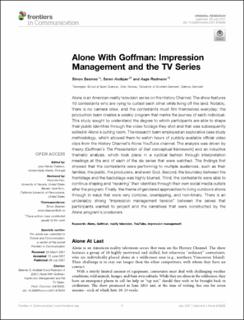| dc.contributor.author | Beames, Simon | |
| dc.contributor.author | Andkjær, Søren | |
| dc.contributor.author | Radmann, Aage | |
| dc.date.accessioned | 2022-03-20T13:25:01Z | |
| dc.date.available | 2022-03-20T13:25:01Z | |
| dc.date.created | 2021-11-01T12:27:05Z | |
| dc.date.issued | 2021 | |
| dc.identifier.citation | Frontiers in Communication. 2021, 6, Artikkel 676555. | en_US |
| dc.identifier.issn | 2297-900X | |
| dc.identifier.uri | https://hdl.handle.net/11250/2986291 | |
| dc.description | This is an open-access article distributed under the terms of the Creative Commons Attribution License (CC BY). The use, distribution or reproduction in other forums is permitted, provided the original author(s) and the copyright owner(s) are credited and that the original publication in this journal is cited, in accordance with accepted academic practice. No use, distribution or reproduction is permitted which does not comply with these terms. | en_US |
| dc.description.abstract | Alone is an American reality television series on the History Channel. The show features 10 contestants who are vying to outlast each other while living off the land. Notably, there is no camera crew, and the contestants must film themselves everyday; the production team creates a weekly program that marks the journey of each individual. This study sought to understand the degree to which participants are able to shape their public identities through the video footage they shot and that was subsequently edited in Alone's cutting room. The research team employed an explorative case study methodology, which allowed them to watch hours of publicly available official video clips from the History Channel's Alone YouTube channel. The analysis was driven by theory (Goffman's The Presentation of Self conceptual framework) and an inductive thematic analysis, which took place in a cyclical fashion through interpretation meetings at the end of each of the six series that were watched. The findings first showed that the contestants were performing to multiple audiences, such as their families, the public, the producers, and even God. Second, the boundary between the frontstage and the backstage was highly blurred. Third, the contestants were able to continue shaping and “repairing” their identities through their own social media outlets after the program. Finally, the theme of gendered approaches to living outdoors shone through in ways that were very complex, overlapping, and non-binary. There is an undeniably strong “impression management tension” between the selves that participants wanted to project and the narratives that were constructed by the Alone program's producers. | en_US |
| dc.language.iso | eng | en_US |
| dc.subject | Alone | en_US |
| dc.subject | Goffman | en_US |
| dc.subject | impression management | en_US |
| dc.subject | reality television | en_US |
| dc.subject | YouTube | en_US |
| dc.title | Alone with Goffman: Impression management and the TV series | en_US |
| dc.type | Peer reviewed | en_US |
| dc.type | Journal article | en_US |
| dc.description.version | publishedVersion | en_US |
| dc.rights.holder | © 2021 Beames, Andkjær and Radmann | en_US |
| dc.source.pagenumber | 9 | en_US |
| dc.source.volume | 6 | en_US |
| dc.source.journal | Frontiers in Communication | en_US |
| dc.identifier.doi | 10.3389/fcomm.2021.676555 | |
| dc.identifier.cristin | 1950171 | |
| dc.description.localcode | Institutt for lærerutdanning og friluftslivsstudier / Department of Teacher Education and Outdoor Studies | en_US |
| dc.source.articlenumber | 676555 | en_US |
| cristin.ispublished | true | |
| cristin.fulltext | original | |
| cristin.qualitycode | 1 | |
